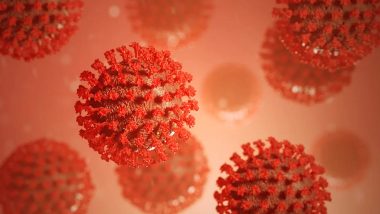New York, August 21: COVID-19 is causing significant dilation of the blood vessels of the lungs, contributing to the very low oxygen levels seen in patients with respiratory failure, according to a new research that may help provide better treatment to those who are severely affected by the disease.
The pilot study of 18 patients, published in the American Journal of Respiratory and Critical Care Medicine, helps explain how COVID-19 behaves differently than classic acute respiratory distress syndrome (ARDS) in which lung inflammation leads to leaky blood vessels in the organ. Can a Simple Pulse Oximeter Detect COVID-19 Symptoms at Home? Here's How the Device Works to Measure Oxygen Levels in Your Body.
In ARDS, the study noted that the leaky blood vessels in the lungs flood the organ with fluid and make it stiff, impairing oxygenation. According to the scientists, including those from the Mount Sinai Hospital in the US, many patients with COVID-19 pneumonia experience severely low levels of oxygen in the blood that is markedly out of proportion to the degree of lung stiffness.
In the current study, the researchers assessed whether the mechanisms leading to low blood oxygen, or hypoxemia, in COVID-19 differ from those in classical ARDS. They used a robotic probe to perform a "bubble study," which is a non-invasive and painless scanning technique using very high frequency sound waves.
"The benefit of using this particular system was that automated monitoring allowed providers to assess cerebral blood flow while minimising the potential for exposure to COVID-19," said study co-author Alexandra Reynolds from Mount Sinai Hospital.
During this study, they injected salt solution with tiny microbubbles into the patient's vein and used the robotic scan device to determine if those microbubbles appear in the blood vessels of the brain.
Under normal circumstances, the scientists said these microbubbles would travel to the right side of the heart, enter the blood vessels of the lungs, and ultimately get filtered by the pulmonary capillaries since the diameter of the bubbles is bigger than the diameter of the tiny blood vessels in the lungs.
If the microbubbles are detected in the blood vessels of the brain, it implied that either there is a hole in the heart, so that blood can travel from the right to the left side of the heart without going through the lungs, or that the capillaries in the lungs are abnormally dilated, allowing the microbubbles to pass through, the study noted.
In the pilot study, the scientists assessed 18 mechanically ventilated patients with severe COVID-19 pneumonia using the bubble study method.
According to the researchers, 15 out of the 18 (83 percent) patients had detectable microbubbles, indicating the presence of abnormally dilated blood vessels in their lungs.
The scientists said the number of microbubbles detected by the device correlated with the severity of lack of oxygen, indicating that the dilation of the blood vessels in the lungs may explain the disproportionate hypoxemia seen in many patients with COVID-19.
The study noted that the number of these microbubbles does not correlate with the severity of low oxygen levels, implying that dilations in the lung blood vessels are not a major mechanism in classical ARDS.
"It is becoming more evident that the virus wreaks havoc on the pulmonary vasculature in a variety of ways," said study senior author Hooman Poor from Mount Sinai Hospital.
"This study helps explain the strange phenomenon seen in some COVID-19 patients known as 'happy hypoxia,' where oxygen levels are very low, but the patients do not appear to be in respiratory distress," Poor said.
If the findings are confirmed in larger studies, the scientists believe the microbubble transit may potentially serve as a marker of disease severity, or even a proxy endpoint in therapeutic trials for COVID-19 pneumonia. "Future studies that investigate the use of pulmonary vascular constrictors in this patient population may be warranted," Poor said.












 Quickly
Quickly


